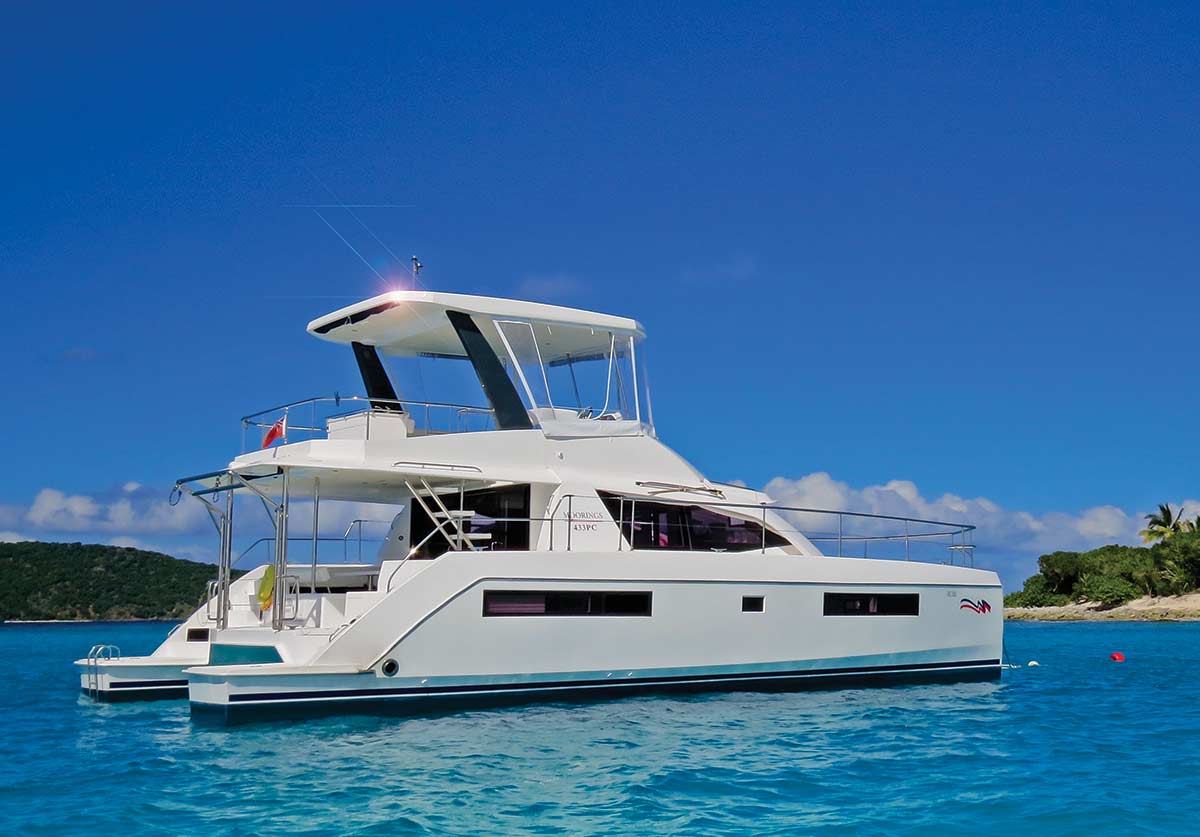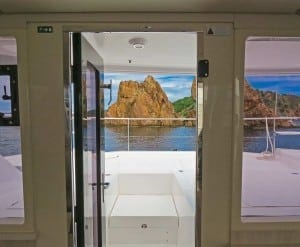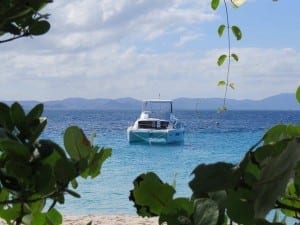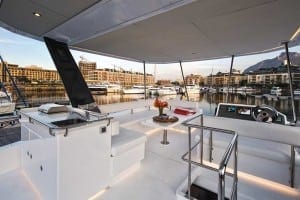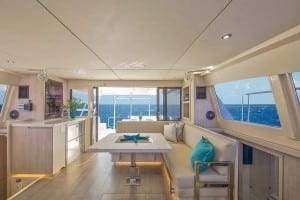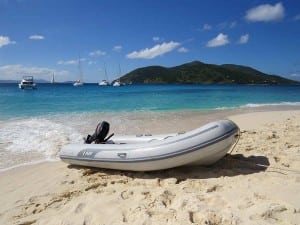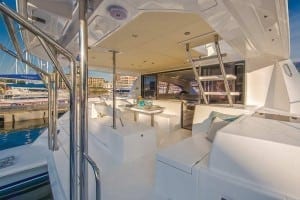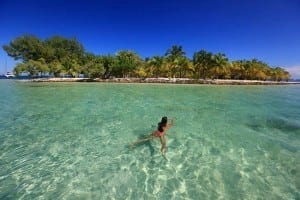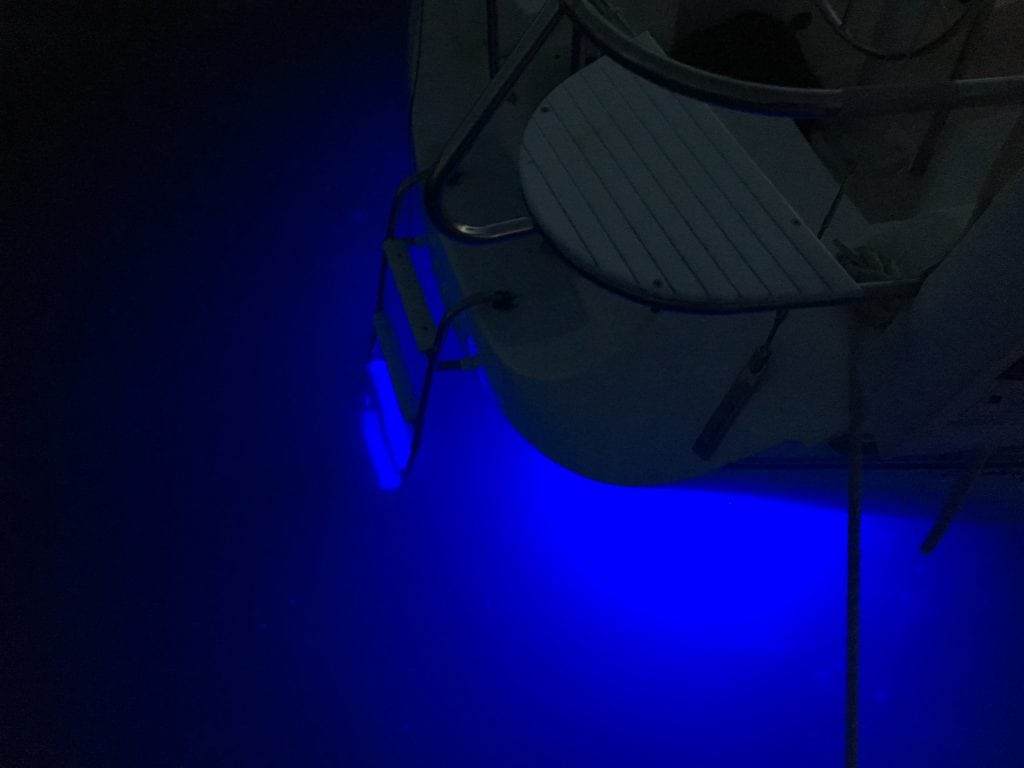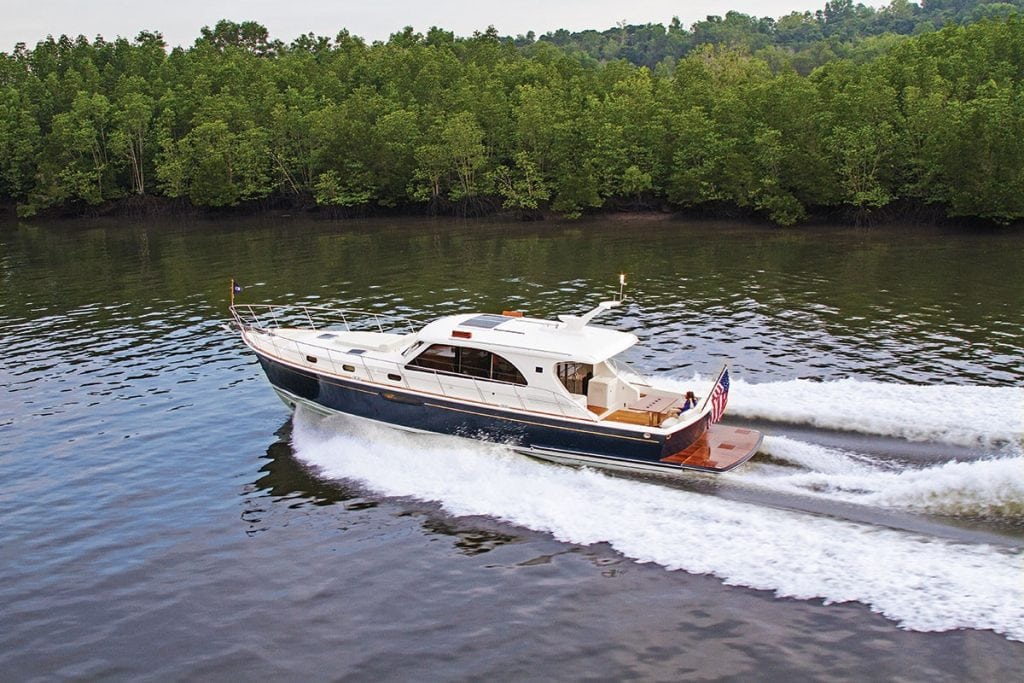A couple of diehard sailors cross to the dark side only to discover that it’s not so dark after all.
In a way, it was a double conversion. Not only were we blow-boaters on a stinkpot, but one with two hulls at that. It was going to take some getting used to, all this space and speed and simplicity. Welcoming the chance to review a 2016 model power catamaran, we chartered a Moorings 433—a Leopard 43 with three cabins. We picked up our boat at The Moorings charter base in Tortola, quite possibly the busiest in the world. Our brand-new owner’s version was named Rubis (French for ruby), and she was already hinting at her gemlike qualities.
Eager to head into the Sir Francis Drake Channel, we put the twin Yanmar 220-hp diesels to work and topped out at 20 knots. (The Moorings keeps the engines on their charter fleet governed down to 80 percent.) We settled into a cruising speed of 14 knots that still left us with more than half of our original fuel level at the end of the charter. Besides the fuel-sipping engines, part of this catamaran’s efficiency comes from the stepped hulls. They are narrow at the waterline for better hydrodynamics but flare out with a hard chine to create interior volume for the cabins. Unlike monohulls, cats aren’t dragging a heavy keel through the water and can operate with smaller engines. We found our diesel engines under the aft bunks and noticed they were surprisingly quiet and vibration-free.
That first night we experienced one of the greatest benefits of a cat: no rolling at anchor. A cat may wobble in a rough bay but it won’t roll, so flopper-stoppers, gyroscopes, stabilizing fins, and sleepless nights are a distant memory.
The next morning, Rubis schooled us on her many on-deck benefits. Her bow was wide and the hard deck (no trampoline) spanned her entire beam. Picking up a mooring was easy; I could move quickly from side-to-side and brace my hips on the stainless steel railing. I then reached down to work the lines on the cleats with both hands. Once done on the foredeck, I stepped through the full-sized forward door into the salon starting what was going to be our normal traffic pattern around the boat. While open, the door blasted air through the interior and cooled it down much faster than any port or hatch ever could.
Catamarans offer extensive exterior spaces, and people congregate mostly in the cockpit. But the flybridge became our favorite spot when driving, sunning, dining, or watching sunsets. Here, a galley module had a Kenyon electric grill and sink. An option on the Leopard 43 is to add a refrigerator or an icemaker, so the party never has to leave the flybridge. All the way forward was a double sunpad suspended over the forward cockpit. With a railing all around, it was a comfortable and safe place to lounge even when under way.
To starboard was the helm that included a double bench seat and an angled dash with two Raymarine MFDs. The autopilot was mounted behind the wheel and the Fusion stereo head was to the side. A better layout of electronics would have helped the driver and her companion to have easier access to all equipment, including the VHF.
It was best to leave the wheel centered and untouched during slow speed maneuvers like docking and anchoring. Just a light touch, usually with one engine at a time, made Rubis dance; no side thrusters or pod drives were needed. With four-bladed props set 20 feet apart, the boat was ultra responsive and absolutely the easiest I’ve ever driven.
Rubis was so much fun to handle that when we picked up a mooring, we argued as to who got to drive. Often we dropped a mooring right after picking it up in favor of one a few feet over in case the breeze was better. We dropped three times in front of Saba Rock at the Bitter End Yacht Club just because we could.
This 43-foot catamaran felt more like a 52-foot monohull. To maximize the spacious feel, Leopard has flipped the salon layout, with the dinette facing forward and up against the cockpit settee. Open the door and windows between the two to create one large living room. The L-shaped galley in the starboard corner faces forward, and I liked looking ahead when cooking under way. To port was a small navigation desk that we used primarily to store cruising guides. It was also the place for charging phones and cameras since there were four USB ports on the bulkhead.
The master stateroom took up the entire starboard hull. A queen-sized bed aft and a large head forward were separated by a vanity, a chest of drawers and two enormous lockers. I could live aboard this boat without having to give away too many clothes. Two cabins in the port hull shared a head and stall shower. (Something that needed a bit of re-thinking were the head light switches that were not in the heads but rather in the corridors outside.)
Boats are sets of tradeoffs, but I found few things to complain about on the Moorings 433. Being nitpicky, however, I would liked to have had a larger electric winch for the dinghy davit that kept tripping the breaker. The windlass, too, was undersized and tended to spin out. Finally, the boarding ladder on the port transom had a challenging angle and little in the way of handholds on top. But that’s the extent of the complaint list, which is much shorter than just about every other boat I’ve seen.
The B.V.I. are permeated with sailing charter boats. However, power cats are quickly gaining ground. The distances are short and the destinations are plentiful so it’s the perfect place for a powerboat and an even better one for a cat. There was very little wind on our first two days of the trip, and we flew past the sailboats on our way to two and three fun anchorages in a day. We sped to the Baths for an early morning swim, then we SUPed around Sandy Cay near Jost Van Dyke followed by snorkeling at the Indians near Norman Island. We finished up with Painkillers at the Last Resort in Trellis Bay. Did we need to circumnavigate Tortola in a day? No, but we easily could have. One day we even went back for more Painkillers—the best I’ve ever tasted.
The builder, Robertson and Caine, expects to build 30 of these Leopard models per year in South Africa. Some will go to The Moorings since they offer power charters in a dozen locations from the Caribbean to Europe to the Seychelles.
Coming from a world of monohull sailboats, we felt a little guilty about how much we enjoyed our power cat and wondered how we could ever go back to half a boat. This was just too easy, too speedy and way too comfortable. We allowed ourselves to voice the reality. Our boat test was really a try-before-you-buy experiment that succeeded. There, we said it. We’re out in the open now and have fully embraced the dark side, a side with plenty of power and two hulls. Though we fought it for years, we are, in every sense of the word, converts.
—By Zuzana Prochazka, Southern Boating Magazine March 2017
SPECIFICATIONS
LOA: 42′ 8″
Beam: 22′ 1″
Draft: 3′ 1″
Displacement (light): 25,794 lbs.
Fuel/Water: 264/212 U.S. gals.
MSRP (base): $525,000 (as tested)
CONTACT
The Moorings
(888) 952-8420
moorings.com


